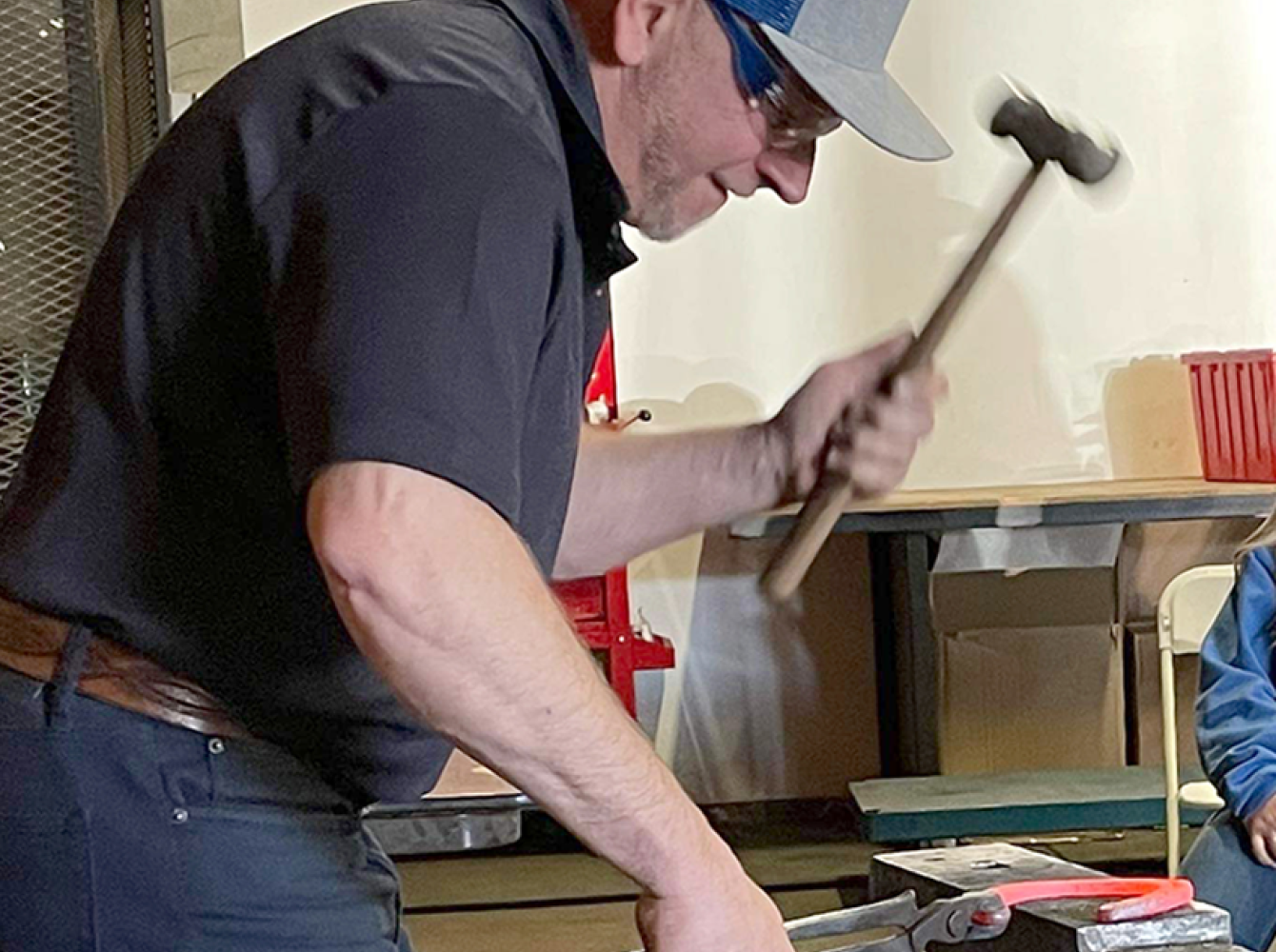
Nigel Fennell, CF, CJF, FE, DWCF, AWCF, FWCF (Honours)
“Every day’s a school day.” You might see Nigel Fennell’s trophies for all he’s accomplished. He sees them for all he’s learned.
The art and science of being Nigel Fennell
Nigel Fennell is one of only three living farriers to have passed the Worshipful Company of Farriers’ Fellowship Exam with Honours, but, believe it or not, he wasn’t sure he’d even finish farrier college.
After struggling his way through school with mild dyslexia, Nigel expected college to be equally challenging. So when he left home in Berkshire, England, to study at Hereford Farriery College, he had a backup plan in place.
If horseshoeing didn't work out, he’d be a stuntman instead—like his famous neighbor, Vic Armstrong, who’d worked with actors like Harrison Ford.
We’ll never know how Nigel would have done as a stuntman though, because he thrived at farrier school. The hands-on teaching style suited him, as did his natural grasp of anatomy, his gift for memorization, his understanding of horses, and even his artistic abilities.
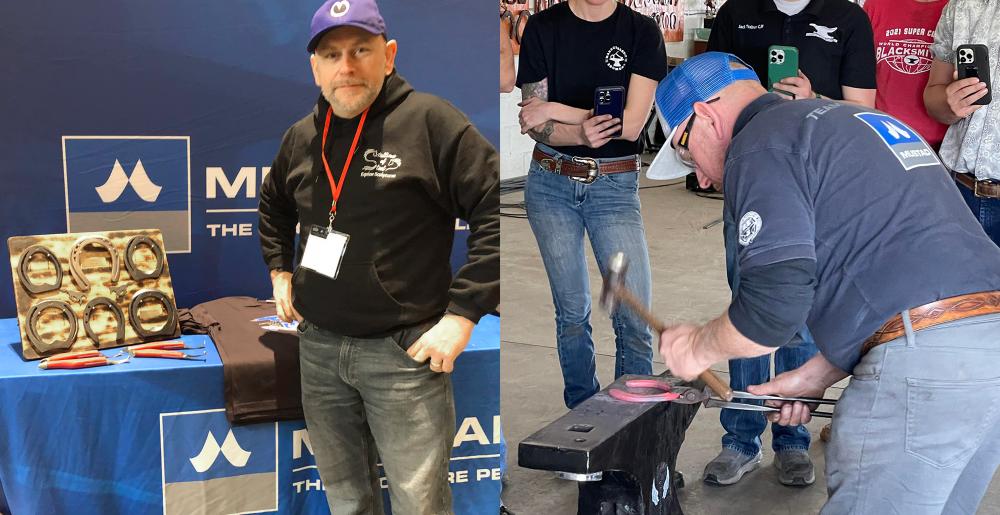
I was a bit worried when I went to college and got an apprenticeship that I was going to struggle. But it was not the case.
School was demanding, but his skills grew quickly.
At Hereford, Nigel soaked up everything he could from farrier legends like Tommy Williams, Graham Sutton, Alan Woodyatt, and Nigel’s master farrier, Tim Godfrey.
Today he realizes how fortunate he was.
“We were only puppies,” he says. “I would love to go back now and see what those men did then—because I would really see what they were doing.” It’s the kind of perspective that comes from a lifetime of watching and learning.
Hitting the ground running with a lucky break
Just before graduating, Nigel got a call from a local farrier, Tim West. He’d seen Nigel’s work and was impressed. Tim was moving to New Zealand—would Nigel want to take over his book?
It was not just a stroke of luck. It was also a momentous challenge.
At 23, Nigel was making more money in a week than he knew how to handle. He was also scrambling to learn the scheduling, pricing, billing, and client side of the business. And, wanting to keep his clients happy, he was making the mistake many young farriers do—he was taking on too many jobs at once, and giving too much away.
But being thrown into the fire helped him focus, and he started catching on. As he did though, he realized he was missing the kind of critical feedback about his work that had been a regular part of school.
That was a good thing. But not a great thing. I wasted a lot of money.
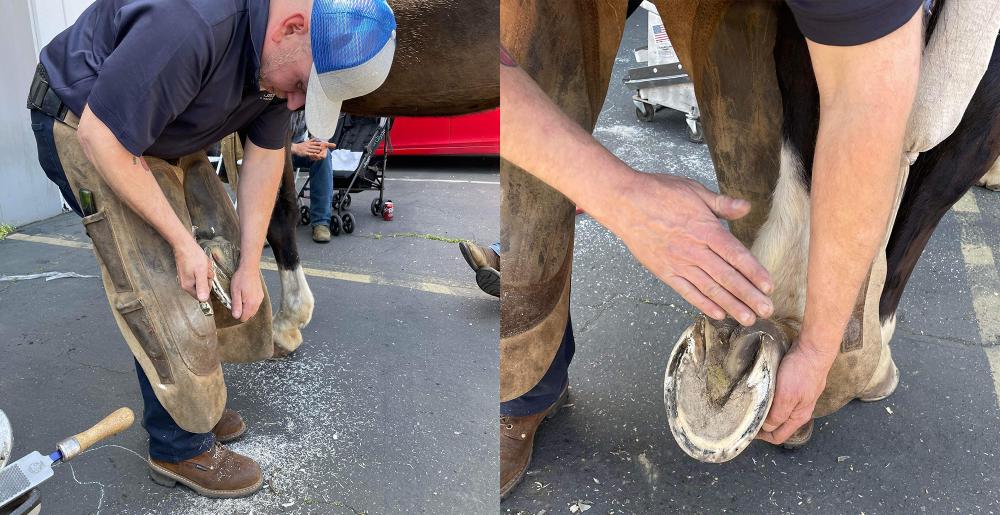
He started looking for new ways to learn.
“As a farrier, the only time you're ever going to be judged, professionally and properly, is when you do a certification or an exam,” he says. “If you never do anything after that, it's done. You’ll get comments from clients and vets, but that’s not the same. You’ll never get to be assessed unless you put yourself out there.”
So Nigel teamed up with two farriers in the area, Adrian Devereux AWCF and Graham Wells AWCF, to keep practicing and learning. The three of them took monthly lessons from Colin Smith FWCF (Honours), a respected senior farrier in the Southern area of England.
Together, they made each other better.
Achieving the first of many firsts
At that time, Adrian and Graham were preparing to test for the Associate exam in the Worshipful Company of Farriers—and they encouraged Nigel to work toward the certification too. It was a crazy idea. Very few farriers Nigel’s age had ever passed the Associate.
Nigel decided to go for it. He dove into the preparations and became one of the youngest members of the Worshipful Company—earning his Associates at only 26.
Well, I'd not even thought about it. He said, ‘Do it. You've not long been out of college. You’ve still got all your fresh studies in your brain.'
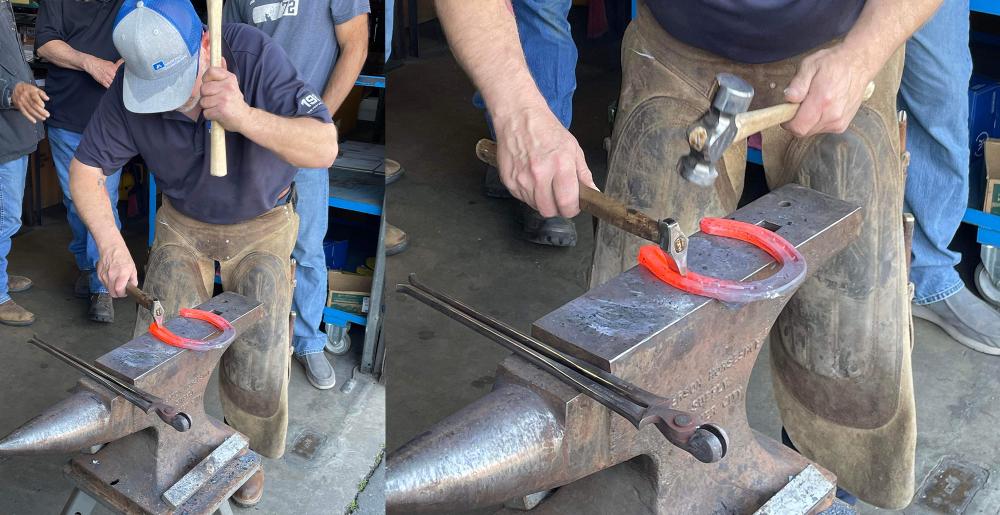
He started competing—not to win, but to learn.
His next goal was to compete in the Royal Show, the largest blacksmithing competition in England at that time, culminating in a four-day event in the National Championship.
He viewed the competition as a clinic, making the gamble that the extra pressure would accelerate his skills and let him see how he compared to the top English talent at the time—people like Billy Crother, Gary Darlow, and Spud Allison, and Jim Blurton.
“It was amazing being in the same arena as the best farriers in England and being able to observe their work,” he says.
By the end of that first competition, Nigel had ranked at number 13, and his career as a world-class competitor, which would include an eight-time stint with the England National Team, had begun.
Nigel’s reason for competing never changed though. For him, it was never about the trophies. It was about becoming a better farrier.
I came in 13th. I felt like I’d won.
A long, chaotic road to America
By 2017, Nigel had made a name for himself in the competition circuit, with a decades-long, successful farrier business in the UK. He was ready for some new challenges and a change of pace.
So he bought some wooded property in Kentucky and started the process of moving his life to America.
He was quickly met by a series of roadblocks.
First, after working hard to secure a visa, he and his wife, Susie Fennell, discovered their legal council had helped them prepare for the wrong kind of visa. The news was devastating. It would take two more years to get the right visa.
Finally, on March 12, 2020, after 30 minutes of grilling by American immigration, he and Susie were approved to go. Two days later, before they could leave the UK, America closed its borders due to Covid-19.
Susie refused to give up. She sleuthed around and discovered they could get to America if they passed through Turkey, as long as they quarantined there for two weeks.
And so, after a few nail-biting weeks in Istanbul, Nigel, Susie, and Zorro, their Jack Russell Terrier, finally stepped into their new country and their new home, which had been sitting empty since their visa rejection two years earlier.
It was quite emotional. Susie, myself, and our little old dog, Zorro, flew to the Atlanta airport, and we drove eight hours to Kentucky, through the night.
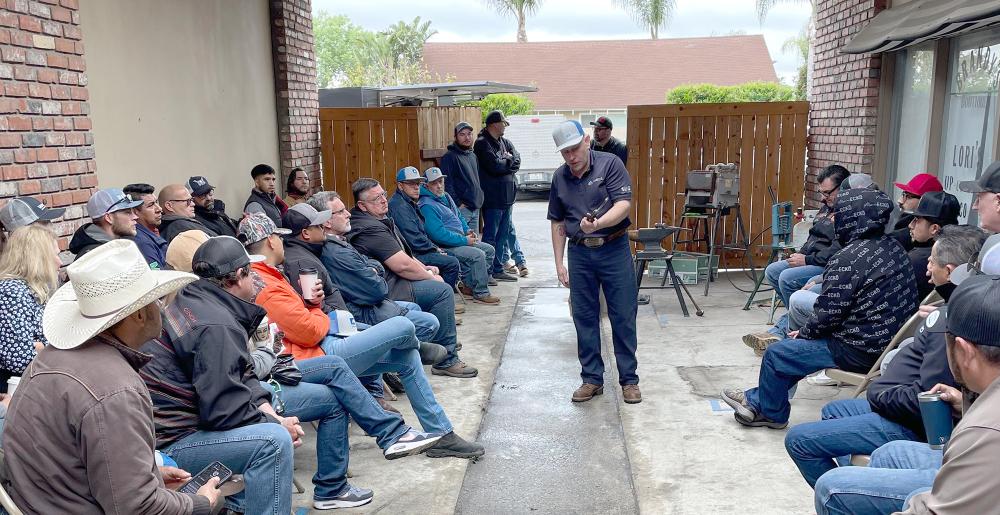
Equipping the next generation
Once they were settled in Irvine, Kentucky, Susie helped Nigel start Foreman’s Forge, a place where farriers can build their skills in a hands-on environment. The school provides post-graduate resources like clinics, private sessions, and even pre-farrier courses.
Nigel’s approach to teaching is based on his decades of experience and his own challenges with learning—and it attracts American farriers who want more from their careers.
“You're not just rushing through a syllabus,” says Nigel. “You're breaking it down, and you're doing it piece by piece, so people can really understand what they're trying to attain. You watch me, then I watch you, then you watch me. You do your work in front of me and other people around and everyone's talking to everybody.”
The man who’d overcome every challenge he’d set for himself as a learner was now a teacher himself.
The whole idea of America wasn't just about coming and getting the property we always wanted. It was about giving back and being at a stage in my life where we could do furthering education clinics.
There was still one challenge left.
Years back, Nigel had become one of the youngest Associates in the Worshipful Company of Farriers. Now he wanted to qualify for their highest honor. He wanted to become a Fellow.
The requirements are daunting: a shoe board of 6-12 shoes; a 5,000-word scientific paper, which must be defended in a 20-minute presentation; and another 20-minute presentation, prepared with only one hour’s notice, on a topic chosen by a team of expert judges.
If he made it through those hurdles, he’d have to successfully complete a high-stakes live shoeing, including performing a live assessment of a horse; determining the proper surgical shoes (along with a veterinarian); hand-forging the shoes; fitting them and finishing them—all within two hours.
Yes it would be difficult, but, as Nigel puts it, “It’s as hard as it should be.”
He kept everyone on the edge of their seats.
When Nigel’s exam day came, he was assigned a large, military, under-muscled horse with a minor history of sesamoditis and suspected collateral ligament desmitis.
The horse looked lame, but seemed nearly sound otherwise.
The vet asked Nigel what he thought of the horse. “I think he looks a bit confused,” he replied.
Then Nigel made his recommendations. They were extensive. He suggested “a pair of whip-across high bar shoes, quarter clipped with a set toe, incorporating some length and support.” He also recommended “cutting the inside medial aspects of the shoes to produce an inner concave section to even up weight/foot location whilst the horse was doing some rehab work up in an arena.”
The examiner listened, and said, “You know you only have two hours to do this.”
“I’ll just have to get a move on,” Nigel replied.
Then the examiner did something unprecedented. He asked Nigel to wait, and he consulted with the other examiners. When he came back, he said, “We’re giving you an extra fifteen minutes—because we really want to see you do it.”
I thought: I have to now show the Worshipful Company what I've been doing for the last 31 years.
Tapping into his lifetime of experience, Nigel asked his striker, his good friend Adrian Devereux AWCF, to cut him a pair at 21 inches of ½ x 1 flat stock, and he got to work. Before long, he’d completed the entire procedure.
In fact, he finished early enough to spend the remaining time on finishing.
“He doesn’t look so confused now, does he?” observed the vet, while Nigel was inspecting the trotting horse.
Nigel had just passed the hardest test of his life, and he’d done it with flying colors.
On that day, Nigel Fennell became a Fellow of the Worshipful Company of Farriers with Honours, the highest accolade in the world of farriery. He’s one of only a few living farriers to have achieved this feat. And he’s still passionate about learning more.
Q&A with Nigel Fennell, FWCF (Honours)
Nigel Fennell continues to shoe a small book of horses in Kentucky, both in his shop and with mobile shoeing services. He and his wife Susie also operate Foreman’s Forge, a unique venue for farriers looking for continuing education.
Nigel is well-known for being a successful international competitor and accomplished farrier. He’s also a talented sculptor who shapes steel into life-size horses, including a famous depiction of The Secretariat, called “God’s Boy 31-2.24.”
We talked to Nigel about his storied career and the new life he and Susie are building in the United States.
You’ve had a long and varied shoeing career. Tell us more about the kinds of work you’ve done.
I’ve worked on all kinds of performance and working horses over the years—everything from happy, leisure riders and drivers, to high-level polo horses, to world-class show jumpers and eventers. Some of the most notable horses I’ve worked with have been for Andrew Hoy, the Olympic Gold and Silver Medalist from Australia, and Richard Barret, the British dressage elitist at Premiere Dressage. I also served the flat race and steeple chase disciplines for many years and, for 25 years, I shod the London Fullers Brewery Shire draught horse show team.
You worked as a surgical farrier for a while as well. Can you tell us about that?
In the later 1990s and 2000s, I was a surgical farrier at the Laminitis clinic in Dauntsey Wiltshire for world Laminitic pioneer Robert Eustace FRCVS. Robert was a huge influence on my remedial trimming and shoeing career.
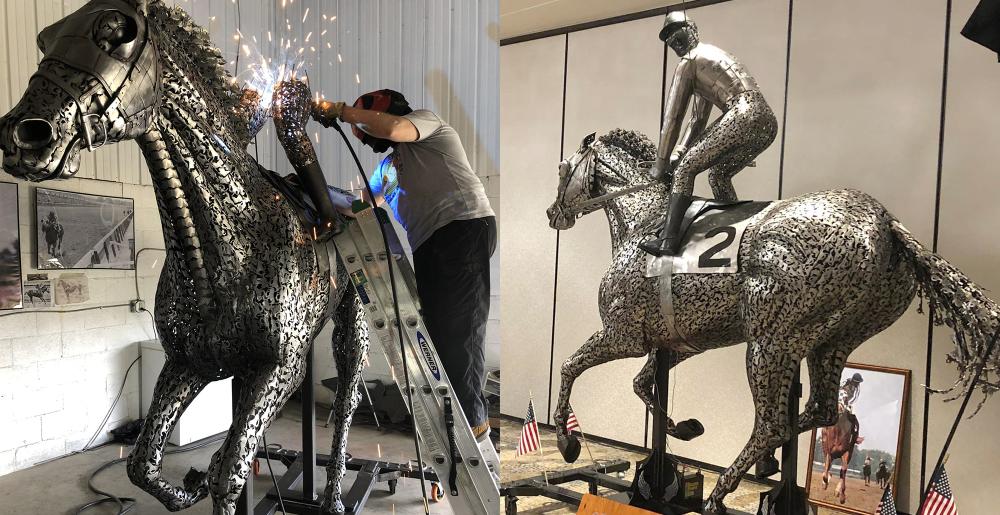
You’ve recently become famous for your horse sculptures. The reveal of the Secretariat on his 50th anniversary year was particularly dramatic. How did that happen?
When we unveiled him, we turned the lights out and I had his heart beating to celebrate his 22-pound heart. His heart was coming through the sculpture and the fabric that covered him. As soon as we took the fabric off, there was this big gasp. People were overwhelmed by him. They were welling up with tears. I looked at their reaction and thought, “I think we did him justice.”
Are you working on any sculptures right now?
I’m sculpting two fighting mustangs in a piece called “Kings of America” that I hope to finish by the end of the year.
When Rob Logsdon from Mustad heard about it, he said, “Right, I'll send you some shoes and nails.” And that was it. So now I’m about halfway through it and hope to finish it by the end of the year. Their torsos are nearly finished, and soon I can start getting a stand and their heads down.
The sculpture was just going to be made of horseshoes, but when Rob sent me this huge crate of nails I thought, well, I need to use some of these nails. So now I've ended up welding thousands of nails inside the shoes. And then I didn't stop at that. I'm adding 500 American stars cut out of steel and will weld them in behind the nose and shoes. And then, this will all be mounted onto an American Flag base.
Let’s go back to your beginnings. What’s the most memorable thing a mentor has said to you?
Colin Smith once said to me, “For now, the job is 90% practical and 10% feel. If you apply yourself properly, there will come a time when it will be 90% feel and 10% practical.“
This is a dangerous trade. Have you ever been hurt by a horse? Did it change your approach?
Yes, and it teaches you a valuable lesson: Until you get kicked and thrown 12 feet, you don’t really respect the power of the horse.
What is it about blacksmithing competitions that drew you in?
I realized that I had overcome my mild dyslexia. I knew I'd overcome studying. And I'd conquered the fact that I could pass a series of exams and then do my diplomacy, so I ticked that box. Then when it came to the competition, it was the same thing. If I put my mind to it, I’d do the work. I wanted to be able to climb that ladder. I'm not saying competition is everything; it’s not. As Muhammad Ali once said, “If a man thinks the same at 50 as he did when he was 20 , then he’s wasted the last 30 years”. I wanted to make those 30 years count in putting myself forward.
Have any competitions changed the way you thought about work?
That would be the World Championships in Calgary in 2007 with Steven Beane FWCF. It was a game-changer to practice with Steven. He is so quick and accurate. It let me know how much ground I had to make up to become more forging efficient.
In competitions you’ve judged for the Worshipful Company, there have been times when you haven’t awarded shoeing medals and/or first place. What’s your reasoning?
Just because something is the best job marked on the floor doesn’t mean it’s worthy of a medal or a first place ribbon. On the rare occasion this has happened they aren’t really happy with you, but my responsibilities are to the company and to the trade and to our (and my) standards. I take that very seriously.
How did you get involved with Mustad?
My connection with Mustad started during my competitive career, like when I was on Team Mustad at the World Championships. I met [Mustad Hoofcare Owner] Hans Mustad a number of times in Calgary and have done clinics with Mustad in England. And then, when I moved to America, that's when obviously Mustad USA realized this crazy English fellow had landed—and then a great team-up began here.